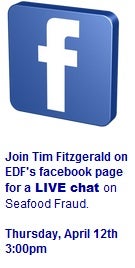 Mislabeled seafood, or seafood fraud, is a hot topic in the fish world these days. Recent exposés by the Boston Globe and Consumer Reports have revealed an alarmingly high rate of seafood deception in restaurants and markets. Conducting DNA testing on fish from local restaurants, the Globe found that about 50% of tested fish were mislabeled. What does this mean? Well, for the average seafood consumer, it means that the fish you pay for is often not the one you actually get.
Mislabeled seafood, or seafood fraud, is a hot topic in the fish world these days. Recent exposés by the Boston Globe and Consumer Reports have revealed an alarmingly high rate of seafood deception in restaurants and markets. Conducting DNA testing on fish from local restaurants, the Globe found that about 50% of tested fish were mislabeled. What does this mean? Well, for the average seafood consumer, it means that the fish you pay for is often not the one you actually get.
Seafood fraud can result in adverse health effects, reinforce the market for illegal fishing, and perpetuate false information about the true state of the marine environment.
But unless you’re a marine biologist, fisherman or seafood purveyor, it can be hard to tell the difference between wild and farmed salmon, red snapper and tilapia, or grouper and Vietnamese catfish (aka basa). The FDA has a list of the most commonly substituted seafood items, but good luck finding this posted anywhere that you buy fish.
 Pinpointing the origins of seafood fraud is difficult. Mislabeling can occur anywhere in the supply chain, further blurring the lines of responsibility and accountability. Sometimes a fish dealer or importer is purposely trying to pull a fast one; other times it’s a simple clerical error on the part of a fishmonger or restaurant owner. Since seafood is the most diverse (and complicated) type of animal protein that we buy, unscrupulous purveyors have lots of opportunities for mischief.
Pinpointing the origins of seafood fraud is difficult. Mislabeling can occur anywhere in the supply chain, further blurring the lines of responsibility and accountability. Sometimes a fish dealer or importer is purposely trying to pull a fast one; other times it’s a simple clerical error on the part of a fishmonger or restaurant owner. Since seafood is the most diverse (and complicated) type of animal protein that we buy, unscrupulous purveyors have lots of opportunities for mischief.
And unfortunately most of them don’t get caught- and consumers fall victim. Without knowing it, we often pay more money for a cheaper fish, but this is only the beginning. Seafood fraud can also result in adverse health effects, reinforce the market for illegal fishing, and perpetuate false information about the true state of the marine environment.
So how can consumers become more seafood savvy and avoid being duped by mislabeled fish? There is no one perfect answer, but here are a few tips:
- Choose a reputable fish purveyor. It sounds simple, but if they get annoyed when you ask questions you shouldn’t be shopping and dining there. It’s OK if they don’t have all the answers, as long as they try to get you the information.
- Educate yourself about commonly substituted species, like salmon, snapper, grouper and rockfish.
- Pay attention to the price. Wild Alaskan salmon rarely dips below $10/pound, whereas generic farmed Atlantic salmon is often half the price. If it looks too good to be true, it probably is.
- Support seafood brands that provide proof of authenticity. GulfWild, for example, is a new program in the Gulf of Mexico that allows the consumer to trace their fish back to the actual boat and captain that landed it using a uniquely-numbered seafood tag. This campaign verifies the traceability, safety and sustainability for 19 species of Gulf red snapper, grouper and tilefish.
- Last but not least, use a frequently updated sustainable seafood guide like the Seafood Selector, to make seafood choices that are good for you and the oceans.
Want to know more? I will be hosting a Facebook chat on Thursday, April 12th at 3:00pm eastern to answer your questions about seafood fraud, mislabeling and how to become a more informed seafood consumer. See you there!









